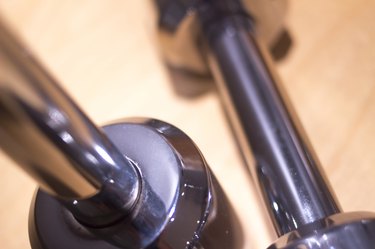
Cervical disk fusion is a major surgical procedure meant to relieve chronic pain caused by pressure on the nerves in the upper spine's disks. When disks degenerate or start to bulge and put pressure on a nerve, even slight movements can cause extreme pain. Cervical fusion involves locking or fusing two or more vertebrae in the neck together so there is less movement. Consult your doctor before resuming any weight-training exercises after surgery.
Before You Start
Video of the Day
Step 1
Talk with your spine surgeon about the various stages of healing, both muscular and bone-related, and the timetable for resuming all kinds of activities, from walking and swimming to weight training and other sports. Doctors typically recommend against exercises and activities that involve a lot of bending and twisting until several months after surgery.
Video of the Day
Step 2
Investigate whether your post-surgical recovery and rehabilitation is covered by your insurance. With coverage, you are able to do weight training and other exercises under the watchful eye of a trainer or physical therapist who can make sure you stick with proper form and manageable weights.
Step 3
Determine how your neck feels as you do everyday activities, such as walking, grocery shopping, gardening and household cleaning. If you're able to handle these functions without pain, you may be ready for some light weight training.
Start Slow and Easy
Step 1
Lift weights or objects that are 10 lbs. or less for the first 6 weeks after surgery -- or longer, depending on your doctor's recommendation.
Step 2
Stick with exercises that don't involve having a weight over your head. These include bicep curls, shoulder flies, pectoral flies or pushups, dumbbell rows and lower-body exercises such as leg presses and calf raises.
Step 3
Opt for machines, rather than free weights, as much as possible to minimize the risk of injury associated with dropping the weight or improper form.
Step 4
Work in weight-training exercises such as bench press, military press and others that involve lifting weights above your head, but do so slowly and with lighter weights at first.
Step 5
Avoid exercises and sports that involve too much pounding or movement of the neck for at least two months or until your doctor recommends you can resume those activities. Examples include running, intense calisthenics, football and basketball.
Things You'll Need
Hand weights
Dumbbells
Weightlifting machines
Tip
Pay attention to the clues your body sends you. If doing a particular exercise seems easy and you feel no stress in your neck and shoulders, consider increasing the weight or number of repetitions. But if you're experiencing even mild pain or discomfort, discontinue that exercise for a while and tell your doctor.
Warning
Avoid situps or crunches that involve having a weight or your hands behind your head until your doctor determines that you are fully healed and can handle that extra pressure.